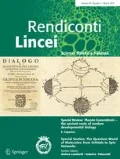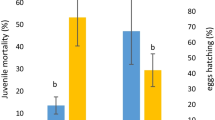Abstract
Root-knot nematodes (RNKs) are injurious plant pests that have been managed mainly by synthetic nematicides. Regardless of their effectiveness, chemical nematicides can be deleterious to the environment and human health. The objective of this study was to assess the ecofriendly nematicidal properties of different crude protein extracts precipitated from Moringa oleifera seeds against the RNK, Meloidogyne incognita, on banana cv. Grande-Naine plants, in comparison with a biological control mean (Azotobacter chroococcum), a marine algae (Ulva lactuca), and a synthetic nematicide (Nemacur 10% G). Various ammonium sulfate concentrations were employed in the fractionation of proteins from M. oleifera. Different ammonium sulfate saturations (50, 60 and 70%) were used to obtain the first, second and third precipitate fractions (PFs), respectively. The in vivo test showed that the first PF gave the greatest reduction in number of nematode juveniles in soil (63.51%) and galls on roots (73.24%). Furthermore, these treatments and the marine algae increased plant growth more than the other tested materials. However, the effects on plant growth did not seem to be related with nematode control. PFs were tested for lectin hemagglutination using a microscopy. Hence, the first PF was the best fraction for the control of the nematode.


Similar content being viewed by others
References
Adamova L, Malinovska L, Wimmerova M (2014) New sensitive detection method for lectin hemagglutination using microscopy. Microsc Res Tech 77:841–849
Adeniyi SA, Orjiekwe CL, Ehiagboare JE, Arimah BD (2010) Preliminary phytochemical analysis and insecticidal activity of ethanolic extracts of four tropical plants (Vernonia amygdalina, Sidaacuta, Ocimum gratissimum and Telfaria occidentalis) against bean weevil (Acanthscelides obtectus). Int J Phys Sci 5(6):753–762
Agrios GN (2005) Plant pathology, 5th edn. Academic press, San Diego
Akinsanya B, Utoh OU, Ukwa UD (2016) Toxicological, phytochemical and anthelminthic properties of rich plant extracts on Clarias gariepinus. J Basic Appl Zool 74:75–86
Al-Saman MA, Farfour SA, Tayel AA, Rizk NM (2015) Bioactivity of lectin from Egyptian Jatropha curcas seeds and its potentiality as antifungal agent. Glob Adv Res J Microbiol 4(7):87–97
Ammer MR, Zaman S, Khalid M, Bilal M, Erum S, Huang D, Che S (2016) Optimization of antibacterial activity of Eucalyptus tereticornis leaf extracts against Escherichia coli through response surface methodology. J Radiat Res Appl Sci 9(4):376–385
Arora DS, Onsare JG (2014) In vitro antimicrobial evaluation and phytoconstituents of Moringa oleifera pod husks. Ind Crops Prod 52:125–135
Bradford MM (1976) A rapid and sensitive method for the quantitation of microgram quantities of protein utilizing the principle of protein-dye binding. Anal Biochem 72:248–254
Carlini CR, Grossi-de-Sá MF (2002) Plant toxic proteins with insecticidal properties: a review on their potentialities as bioinsecticides. Toxicon 40(11):1515–1539
Claudius-Cole AO, Aminu AE, Fawole B (2010) Evaluation of plant extracts in the management of root-knot nematode Meloidogyne incognita on cowpea [Vigna unguiculata]. Mycopath 8(2):53–60
Coelho JS, Santos ND, Napoleão TH, Gomes FS, Ferreira RS, Zingali RB, Coelho LC, Leite SP, Navarro DM, Paiva PM (2009) Effect of Moringa oleifera lectin on development and mortality of Aedes aegypti larvae. Chemosphere 77(7):934–938
Dang L, Van Damme EJ (2015) Toxic proteins in plants. Phytochemistry 117:51–64
El-Ansary MSM, Hamouda RA (2014) Biocontrol of root knot nematode infected banana plants by some marine algae. Russ J Mar Biol 40(2):140–146
Etzler ME (1986) Distribution and function of plant lectins. In: Liener IE, Sharon N, Goldstein IJ (eds) The lectins. Academic Press, San Diego, pp 371–435
Fahey JW (2005) Moringa oleifera: a review of the medical evidence for its nutritional, therapeutic, and prophylactic properties. Part 1. Tree Life J 1:5
Fakayode OA, Ajav EA (2016) Process optimization of mechanical oil expression from Moringa (Moringa oleifera) seeds. Ind Crops Prod 90:142–151
Foidl N, Makkar HPS, Becker K (2001) The potential of Moringa oleifera for agricultural and industrial uses. What development potential for Moringa products? October 20th–November 2nd 2001. Dar Es Salaam, Tanzania
Gahukar RT (2012) Evaluation of plant-derived products against pests and diseases of medicinal plants: a review. Crop Protect 42:202–209
Govardhan Singh RS, Negi PS, Radha C (2013) Phenolic composition, antioxidant and antimicrobial activities of free and bound phenolic extracts of Moringa oleifera seed flour. J Funct Food 5:1883–1891
Guil-Guerrero JL, Ramos L, Moreno C, Zúñiga-Paredes JC, Carlosama-Yepez M, Ruales P (2016) Antimicrobial activity of plant-food by-products: a review focusing on the tropics. Livest Sci 189:32–49
Hassan N, El-bastawisy Z, Ebeed H, Nemat Alla M (2015) Role of defense enzymes, proteins, solutes and Δ1-pyrroline-5-carboxylate synthase in wheat tolerance to drought. Rend Fis Acc Lincei 26(3):281–291
Hebert GA, Pelham PL, Pittman B (1973) Determination of the optimal ammonium sulfate concentration for the fractionation of rabbit, sheep, horse, and goat antisera. Appl Microbiol 25(1):26–36
Hussey RS, Barker KR (1973) A comparison of methods of collecting inocula of Meloidogyne spp., including a new technique. Plant Dis Rep 57:1025–1028
Ioannina OG, Dimitrios GK, Demetra PA (2004) A novel non-chemical nematicide for the control of root-knot nematodes. Appl Soil Ecol 26:69–79
Izuogu NB, Badmos AA, Raji SO (2013) The potency of Moringa oleifera and Jatropha curcas leaf extracts as control for root-knot-nematode in maize (Zea mays). Int J Phytofuels Allied Sci 2(1):116–124
Javed N, Gowen SR, El-Hassan SA, Inam-ul-Haq M, Shahina F, Pembroke B (2008) Efficacy of neem (Azadirachta indica) formulations on biology of root-knot nematodes (Meloidogyne javanica) on tomato. Crop Prot 27:36–43
Kosma P, Ambang Z, Begoude BAD, Ten Hoopen GM, Kuaté J, Akoa A (2011) Assessment of nematicidal properties and phytochemical screening of neem seed formulations using Radopholus similis, parasitic nematode of plantain in Cameroon. Crop Prot 30(6):733–738
Marban-Mendoza N, Jeyaprakash A, Jansson H-B, Damon JRRA, Zuckerman BM (1987) Control of root-knot nematodes on tomato by lectins. J Nematol 19(3):331–335
Napoleão TH, Gomes FS, Lima TA, Santos NDL, Sá RA, Albuquerque AC, Coelho LCBB, Paiva PMG (2011) Termiticidal activity of lectins from Myracrodruon urundeuva against Nasutitermes corniger and its mechanisms. Int Biodeterior Biodegrad 65:52–59
Paiva PMG, Napoleão TH, Sá RA, Coelho LCBB (2012). Insecticide activity of lectins and secondary metabolites, insecticides—advances in integrated pest management. In: Farzana Perveen (ed), ISBN: 978-953-307-780-2, InTech, Available from: http://www.intechopen.com/books/insecticides-advances-in-integrated-pest-management/insecticide-activityof-lectins-and-secondary-metabolites
Paliwal R, Sharma V, Pracheta E (2011) A review on horse radish tree (Moringa oleifera): a multipurpose tree with high economic and commercial importance. Asian J Biotechnol 3(4):317–318
Pavaraj M, Bakavathiappan G, Baskaran S (2012) Evaluation of some plant extracts for their nematicidal properties against root-knot nematode, Meloidogyne incognita. J Biopestic 5 (Supplementary):106–110
Pretali L, Bernardo L, Butterfield TS, Trevisan M, Lucini L (2016) Botanical and biological pesticides elicit a similar induced systemic response in tomato (Solanum lycopersicum) secondary metabolism. Phytochemistry 130:56–63
Ratshilivha N, Awouafack MD, du Toit ES, Eloff JN (2014) The variation in antimicrobial and antioxidant activities of acetone leaf extracts of 12 Moringa oleifera (Moringaceae) trees enables the selection of trees with additional uses. S Afr J Bot 92:59–64
Salles HO, Braga ACL, Nascimento MTC, Sousa AMP, Lima AR, Vieira LS, Cavalcante ACR, Egito AS, Andrade LBS (2014) Lectin, hemolysin and protease inhibitors in seed fractions with ovicidal activity against Haemonchus contortus. Revista Brasileira de ParasitologiaVeterinária 23(2):136–143
Santos AFS, Luz LA, Argolo ACC, Teixeira JA, Paiva PMG, Coelho LCBB (2009) Isolation of a seed coagulant Moringa oleifera lectin. Process Biochem 44(4):504–508
Sikora RA, Fernandez E (2005) Nematode parasites of vegetables. In: Luc M, Sikora RA, Bridge J (eds) Plant-parasitic nematodes in subtropical and tropical agriculture, 2nd edn. CABI Publishing, Wallingford, pp 319–392
Sokal RR, Rohlf FJ (1995) Biometry: The Principles and practice of statistics in biological research, 3rd edn. W.H. Freeman and Co., New York
Zhao L, Feng C, Wu K, Chen W, Chen Y, Hao X, Wu Y (2017) Advances and prospects in biogenic substances against plant virus: a review. Pestic Biochem Physiol 135:15–26
Acknowledgements
We gratefully acknowledge Dr. Assma Abd Ella, University of Sadat City, for critical reading of the manuscript.
Author information
Authors and Affiliations
Corresponding author
Rights and permissions
About this article
Cite this article
El-Ansary, M.S.M., Al-Saman, M.A. Appraisal of Moringa oleifera crude proteins for the control of root-knot nematode, Meloidogyne incognita in banana. Rend. Fis. Acc. Lincei 29, 631–637 (2018). https://doi.org/10.1007/s12210-018-0692-9
Received:
Accepted:
Published:
Issue Date:
DOI: https://doi.org/10.1007/s12210-018-0692-9




